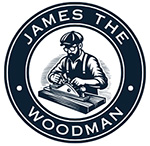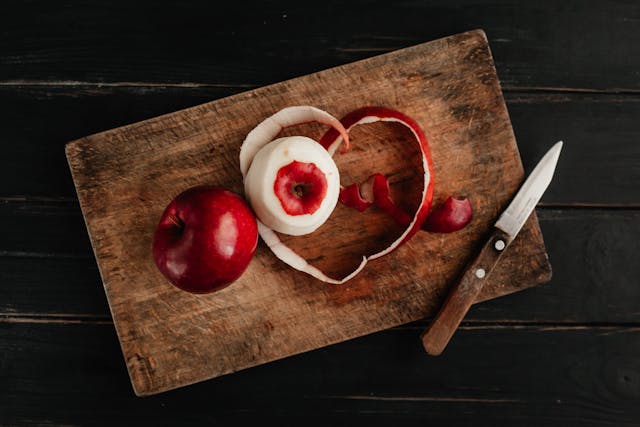Hello, I’m James the Woodman. I’ve been crafting wooden cutting boards by hand for over twenty years, focusing especially on the beautiful and durable end grain boards. I work with hardwoods like walnut, maple, cherry, and beech to create pieces that are not only functional but also works of art. One of the questions I get asked most frequently is: “What’s the deal with self-healing wooden boards? Is that a real thing?” The answer is yes, and today I’m going to walk you through exactly what that means, how it works, and why you should care—especially if you’re serious about your knives or your kitchen.
What Is an End Grain Cutting Board?
Before we get into the self-healing magic, it’s important to understand what an end grain board is. Wood has three primary grain orientations: face grain, edge grain, and end grain. In an end grain board, the wood fibers are oriented vertically, so when you look at the surface of the board, you’re seeing the ends of the wood fibers.
This construction technique is what makes end grain boards so resilient. Unlike edge or face grain boards, when you cut on an end grain board, your knife goes between the fibers rather than across them. This preserves both your knife edge and the board itself.
How Do Wooden Boards Self-Heal?
Now for the fun part—how does a wooden board “self-heal”?
When you slice into an end grain cutting board, the wood fibers part slightly to accommodate the knife. After you remove the blade, the fibers naturally move back into place. This isn’t magic—it’s a result of the wood’s natural cellular structure, particularly in dense hardwoods like maple and walnut. The fibers in these woods are flexible and resilient enough to bounce back after being compressed.
Over time, of course, the effect diminishes with very deep cuts or constant heavy use. But if you take good care of your board—regular oiling, cleaning, and avoiding extreme moisture—you’ll see this self-healing behavior extend the life of your board dramatically.
The Science Behind the Magic
Wood is an organic, fibrous material made up of long, hollow cells called tracheids and vessels. These act like tiny straws, which once carried water and nutrients through the living tree. When these cells are cut into end grain, they can compress and re-expand with surprising elasticity.
This is why end grain boards are preferred by professional chefs and passionate home cooks alike. They show fewer knife marks, last longer, and offer a better surface for maintaining sharp knife edges. It’s not just a matter of aesthetics—it’s about performance and longevity.
Comparing End Grain with Other Boards
A lot of folks walk into my workshop and wonder why end grain boards are more expensive. Once I explain the self-healing nature and the labor involved in creating them, it starts to make sense.
Edge grain boards, for example, are made by gluing long strips of wood together side-by-side. They’re strong, but every knife cut slices directly across the fibers. That means more visible damage and quicker wear on both the board and your knives.
Face grain boards are often the cheapest and are mostly decorative or light-use items. They look lovely but are not suited to daily chopping and slicing.
Plastic boards? Don’t get me started. They might be cheap, but they dull knives fast and can harbor bacteria in the knife grooves. Plastic doesn’t self-heal—it just holds onto damage. Wood, on the other hand, has natural antimicrobial properties and the added bonus of healing itself—if it’s made the right way.
Craftsmanship and the Making of Self-Healing Boards
Crafting an end grain board is a labor of love. It involves multiple steps of cutting, gluing, clamping, planing, sanding, and finishing. I start by selecting the right hardwoods—not just for beauty, but for grain orientation, density, and resilience. I cut these into uniform blocks, then rotate each piece so the end grain faces upward. After gluing them together in a precise pattern, I clamp the board tightly and let it cure for 24 hours.
Then comes the sanding—a dusty, time-consuming process to achieve a perfectly smooth surface. Finally, I apply several coats of food-grade mineral oil and beeswax, which penetrate the fibers and protect them from moisture.
All of this work is done with the goal of creating a board that heals itself and serves you for decades.
Care Tips to Maximize the Self-Healing Effect
Even the best board needs a little love to keep working its magic. Here’s how to care for your end grain cutting board so it retains its self-healing properties:
- Oil Regularly – Use food-grade mineral oil or a board conditioner made with beeswax. This keeps the fibers supple and helps them spring back after cuts.
- Avoid Soaking – Never submerge your board in water. A quick rinse and wipe is all it needs. Excessive water can cause warping or cracking.
- Dry Upright – Let the board dry on its side to prevent water pooling underneath.
- Use Both Sides – Alternate sides to distribute wear evenly.
- Resand if Needed – If your board starts to show stubborn knife marks, a light sanding and re-oiling can bring it back to life.
Why It Matters
We live in a time when most products are made to be disposable. But a self-healing end grain cutting board defies that logic. It’s a tool meant to last, getting better with age when properly cared for. For me, making these boards is about more than woodworking—it’s about sustainability, craftsmanship, and respect for the materials we use every day in our kitchens.
A well-made end grain board becomes a part of your cooking journey. It absorbs the energy of your meals, from rushed weeknight dinners to slow weekend feasts. And unlike a plastic board, it carries a story. That story is told not in gouges and scars, but in resilience and quiet strength.
Final Thoughts
So yes, wooden boards—especially end grain ones—do “self-heal.” It’s not a marketing gimmick or a myth. It’s a property of the material itself, amplified by thoughtful craftsmanship and proper care.
If you’re ever in the market for a cutting board that respects your tools, elevates your kitchen, and will be with you for years to come, consider investing in a handmade end grain board. And if you’re ever nearby, come visit my workshop—I’ll be happy to show you the difference firsthand.
— James the Woodman
Have you ever used an end grain board before?

